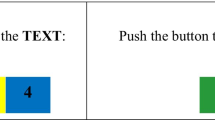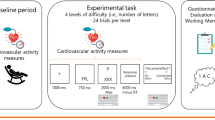Abstract
Two experiments examined task engagement, quantified as cardiovascular (CV) response, under conditions of high self-relevance of performance (i. e., when performance had strong implications for the individual's self-definition and self-esteem). Experiment 1 involved a 2 (self-relevance) × 2 (task difficulty) design and revealed, in accordance with predictions derived from Brehm's energization model, that self-relevance per se does not result in high engagement, but that high self-relevance bound up with high task difficulty does. Experiment 2 involved three difficulty conditions (very easy, moderate, very difficult) under highly self-relevant performance conditions and revealed a curvilinear difficulty/engagement relationship. In both studies CV responses were independent of feeling states.
Similar content being viewed by others
REFERENCES
Atkinson, J. W. (1957). Motivational determinants of risk-taking behavior. Psychological Review, 64, 359–372.
Atkinson, J. W. (1958). Towards experimental analysis of human motivation in terms of motives, expectancies, and incentives. In J. W. Atkinson (Ed.), Motives in fantasy, action, and society (pp. 289–305). Princeton, NJ: Van Nostrand.
Baumeister, R. F. (1986). Identity: Cultural change and struggle for self. New York: Oxford University Press.
Berlyne, D. E. (1960). Conflict, arousal, and curiosity. New York: McGraw-Hill.
Berntson, G. G., Cacioppo, J. T., & Quigley, K. S. (1993). Cardiac psychophysiology and autonomic space in humans: Empirical perspectives and conceptual implications. Psychological Bulletin, 114, 296–322.
Biner, P. M. (1987). Effects of difficulty and goal value on valence. Journal of Research in Personality, 21, 395–404.
Blascovich, J., & Tomaka, J. (1996). The biopsychosocial model of arousal regulation. In M. P. Zanna (Ed.), Advances in experimental social psychology (Vol. 28, pp. 1–51). New York: Academic Press.
Brehm, J. W., & Brummett, B. H. (1998). The emotional control of behavior. In M. Kofta, G. Weary, & G. Sedek (Eds.), Personal control in action: Cognitive and motivational mechanisms (pp. 133–154). New York: Plenum.
Brehm, J. W., & Self, E. A. (1989). The intensity of motivation. Annual Review of Psychology, 40, 109–131.
Brehm, J. W., Wright, R. A., Solomon, S., Silka, L., & Greenberg, J. (1983). Perceived difficulty, energization, and the magnitude of goal valence. Journal of Experimental Social Psychology, 19, 21–48.
DeCharms, R. (1968). Personal causation: The internal affective determinants of behavior. New York: Plenum.
Easterbrook, J. A. (1959). The effect of emotion on cue utilization and the organization of behavior. Psychological Review, 66, 183–201.
Eysenck, M. W. (1982). Attention and arousal. New York: Springer.
Frijda, N. (1986). The emotions. Cambridge: Cambridge University Press.
Gendolla, G. H. E. (1998). Effort as assessed by motivational arousal in identity relevant tasks. Basic and Applied Social Psychology, 20, 111–121.
Helson, H. (1964). Adaption-levle theory. New York: Harper & Row.
Hoppe, F. (1930). Untersuchungen zur Handlungs-und Affektpsychologie. IX. Erfolg und Mißerfolg. [Investigations in the psychology of action and affect. IX. Success and failure]. Psychologische Forschung, 14, 1–63.
Humphreys, M. S., & Revelle, W. (1984). Personality, motivation, and performance: A theory of the relationship between individual differences and information processing. Psychological Review, 91, 153–184.
Izard, C. E. (1977). Human emotions. New York: Plenum Press.
Klein, G. S., & Schoenfeld, N. (1941). The influence of ego-involvement on confidence. Journal of Abnormal and Social Psychology, 36, 249–258.
Lazarus, R. S. (1991). Emotion and adaption. New York: Oxford University Press.
Levenson, R. W. (1992). Autonomic nervous system differences among emotions. Psychological Science, 3, 23–27.
Llabre, M. M., Spitzer, S. B., Saab, P. G., Ironson, G. H., & Schneiderman, N. (1991). The reliability and specificity of delta versus residualized change as measure of cardiovascular reactivity to behavioral challenges. Psychophysiology, 28, 701–711.
Locke, E. A., & Latham, G. P. (1990). A theory of goal setting and task performance. Englewood Cliffs, NJ: Prentice Hall.
Meyer, W.-U., & Hallermann, B. (1977). Intended effort and informational value of task outcome. Archiv für Psychologie, 129, 131–140.
Nicholls, J. G. (1984). Achievement motivation: Conceptions of ability, subjective experience, task choice, and performance. Psychological Review, 91, 328–346.
Obrist, P. A. (1976). The cardiovascular-behavioral interaction as it appears today. Psychophysiology, 13, 95–107.
Obrist, P. A. (1981). Cardiovascular psychophysiology: A perspective. New York: Plenum Press.
Pennebaker, J. W. (1982). The psychology of physical symptoms. New York: Springer.
Pyszczynski, T., & Greenberg, T. (1983). Determinants of reduction in intended effort as a strategy for coping with anticipated failure. Journal of Research in Personality, 17. 412–422.
Reed, S. D., Harver, A., & Katkin, E. S. (1990). Interoception. In J. T. Cacioppo & L. G. Tassinary (Eds.), Principles of psychophysiology. Physical, social, and inferential elements (pp. 253–294). New York: Cambridge University Press.
Rhodewalt, F., & Fairfield, M. (1991). Claimed self-handicaps and the self-handicapper: The relation of reduction in intended effort to performance. Journal of Research in Personality, 25, 402–417.
Roberson, B. F., & Wright, R. A. (1994). Difficulty as a determinant of interpersonal appeal: A social-motivational application of energization theory. Basic and Applied Social Psychology, 15, 373–388.
Sigall, H., & Mills, J. (1998). Measures of independent variables and mediators are useful in social psychological experiments: But are they necessary? Personality and Social Psychology Review, 2, 218–226.
Smith, T. W., Baldwin, M., & Christensen, A. J. (1990). Interpersonal influence as active coping: Effects of task difficulty on cardiovascular reactivity. Psychophysiology, 27, 429–437.
Tesser, A. (1989). Toward a self-evaluation maintenance model of social behavior. In L. Berkowitz (Ed.), Advances in experimental social psychology (Vol. 21, pp. 181–227). New York: Academic Press.
Thayer, R. E. (1970). Activation states as assessed by verbal report and four psychophysiological variables. Psychophysiology, 7, 86–94.
Thayer, R. E. (1978). Toward a psychological theory of multidimensional activation (arousal). Motivation and Emotion, 2, 1–34.
Wicklund, R. A., & Gollwitzer, P. M. (1982). Symbolic self-completion. Hillsdale, NJ: Erlbaum.
Winer, B. J. (1971). Statistical principles in experimental design. New York: McGraw-Hill.
Wood, C. G., & Hokanson, J. E. (1965). Effects of induced muscular tension on performance and the inverted U function. Journal of Personality and Social Psychology, 1, 506–510.
Wright, R. A. (1996). Brehm's theory of motivation as a model of effort and cardiovascular response. In P. M. Gollwitzer & J. A. Bargh (Eds.), The psychology of action: Linking cognition and motivation to behavior (pp. 424–453). New York: Guilford.
Wright, R. A., & Brehm, J. W. (1989). Energization and goal attractiveness. In L. A. Pervin (Ed.), Goal concepts in personality and social psychology (pp. 169–210). Hillsdale, NJ: Erlbaum.
Wright, R. A., Brehm, J. W., Crutcher, W., Evans, M. T., & Jones, A. (1990). Avoidant control difficulty and aversive incentive appraisals: Additional evidence of an energization effect. Motivation and Emotion, 14, 45–73.
Wright, R. A., Contrada, R. J., & Patane, M. J. (1986). Task difficulty, cardiovascular response, and the magnitude of goal valence. Journal of Personality and Social Psychology, 51, 873–843.
Wright, R. A., Dill, J. C., Geen, R. G., & Anderson, C. A. (in press). Social evaluation influence on cardiovascular response to a fixed behavioral challenge: Effects across a range of difficulty levels. Annals of Behavioral Medicine.
Wright, R. A., Shaw, L. L., & Jones, C. R. (1990). Task demand and cardiovascular response magnitude: Further evidence of the mediating role of success importance. Journal of Personality and Social Psychology, 59, 1250–1260.
Wright, R. A., Tunstall, A. M., Williams, B. J., Goodwin, J. S., & Harmon-Jones, E. (1995). Social evaluation and cardiovascular response: An active coping approach. Journal of Personality and Social Psychology, 69, 530–543.
Yerkes, R. M., & Dodson, J. D. (1908). The relation of strength of stimulus to rapidity of habit-formation. Journal of Comparative and Neurological Psychology, 18, 459–482.
Author information
Authors and Affiliations
Rights and permissions
About this article
Cite this article
Gendolla, G.H.E. Self-Relevance of Performance, Task Difficulty, and Task Engagement Assessed as Cardiovascular Response. Motivation and Emotion 23, 45–66 (1999). https://doi.org/10.1023/A:1021331501833
Issue Date:
DOI: https://doi.org/10.1023/A:1021331501833




